Report on Managing Financial Resources and Decisions for Business
VerifiedAdded on 2020/02/05
|22
|5728
|86
Report
AI Summary
This report analyzes the management of financial resources and decision-making processes within a business context. It begins by identifying various sources of finance, including short-term, medium-term, and long-term options such as bank loans, owner's equity, and venture capital, evaluating their respective impacts and costs. The report then delves into the importance of financial planning, emphasizing its role in coordinating activities, assessing funding sources, and optimizing capital structure. Additionally, the report assesses the information required for financial decision-making, highlighting the needs of managers, government entities, investors, and suppliers. Furthermore, the report explores the impact of financial decisions on financial statements, demonstrating how effective financial management leads to increased profitability. Finally, the report covers the preparation of cash budgets, unit cost calculations, pricing decisions, and project appraisal techniques, along with an overview of key financial statements and ratio analysis. The report uses XYZ foods as a case study for small business financial management.
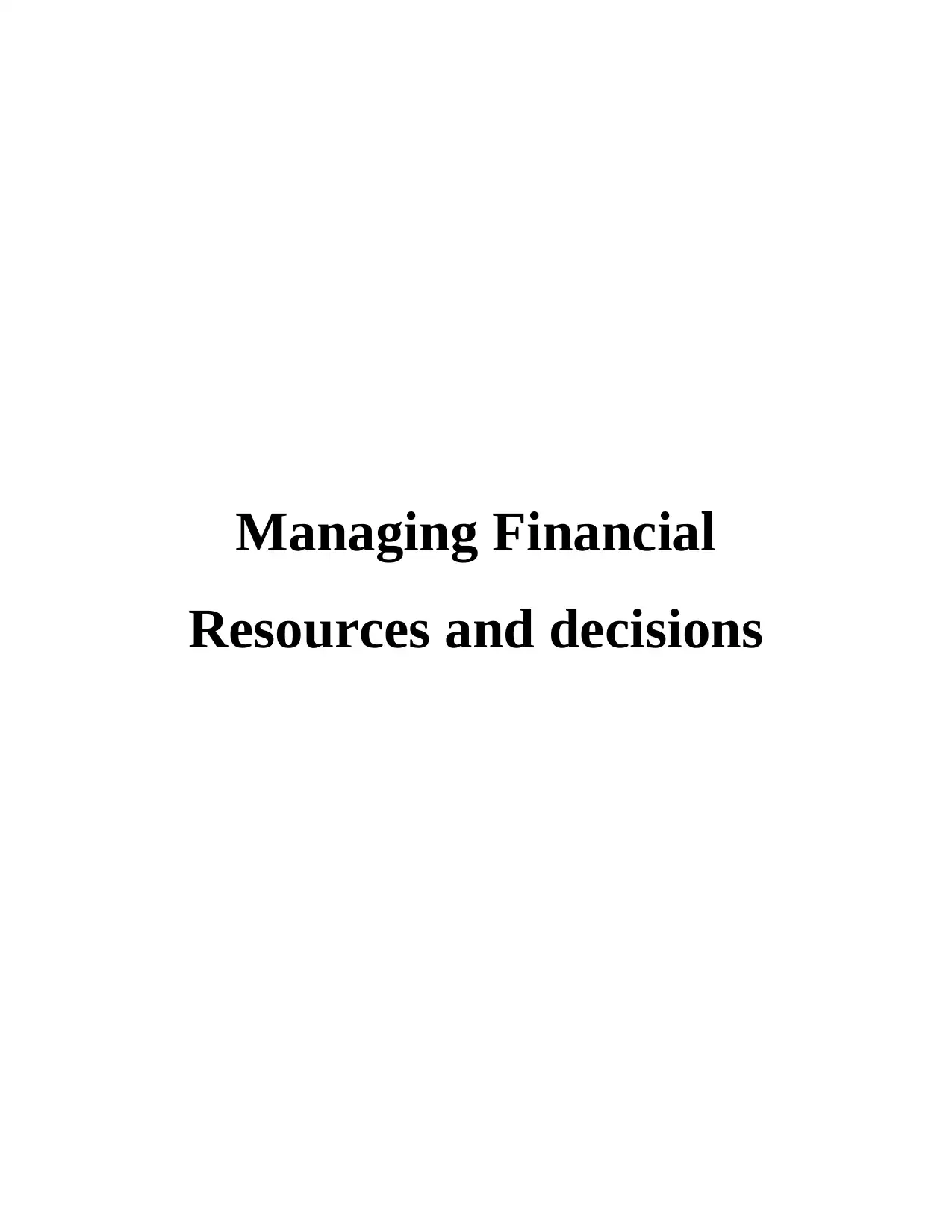
Managing Financial
Resources and decisions
Resources and decisions
Paraphrase This Document
Need a fresh take? Get an instant paraphrase of this document with our AI Paraphraser
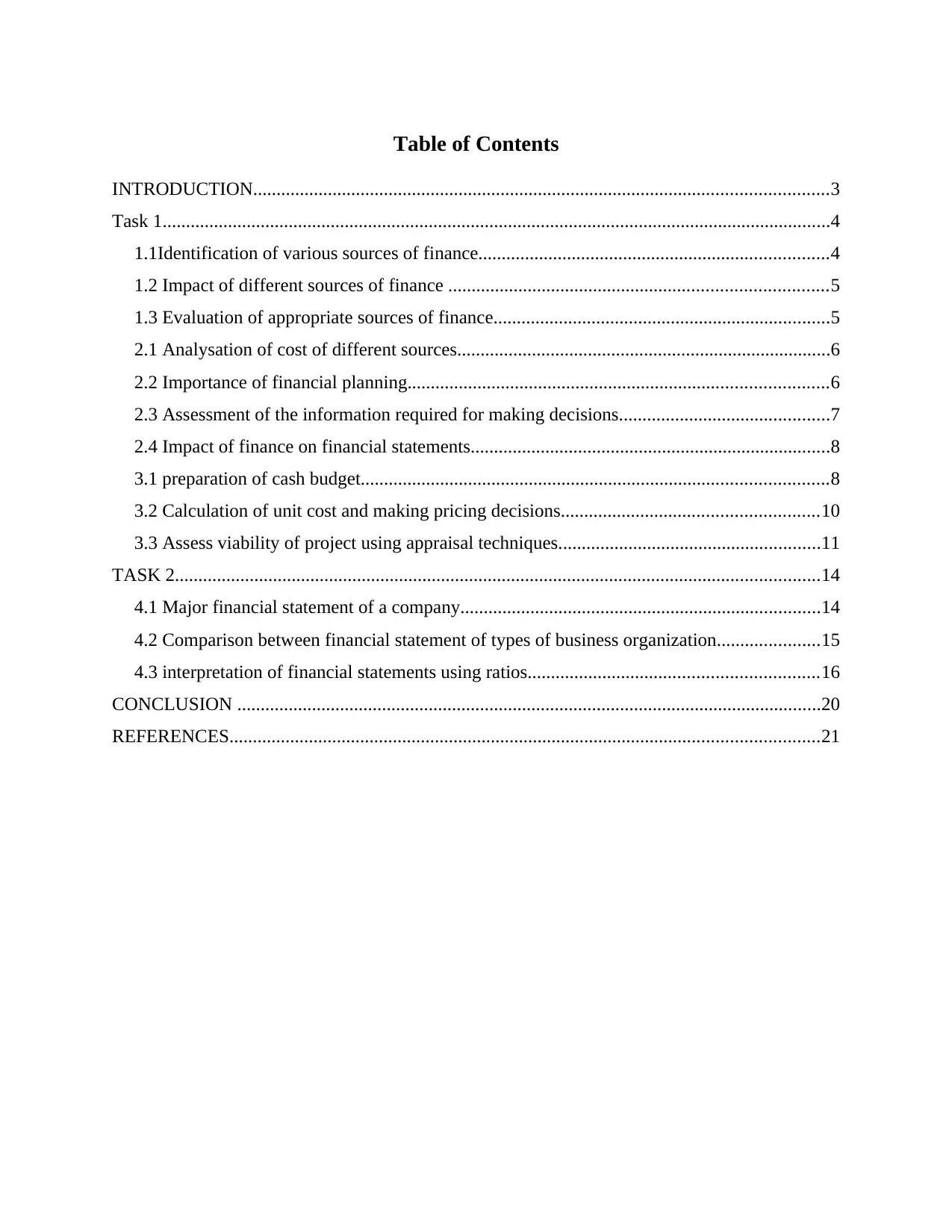
Table of Contents
INTRODUCTION...........................................................................................................................3
Task 1...............................................................................................................................................4
1.1Identification of various sources of finance...........................................................................4
1.2 Impact of different sources of finance .................................................................................5
1.3 Evaluation of appropriate sources of finance........................................................................5
2.1 Analysation of cost of different sources................................................................................6
2.2 Importance of financial planning..........................................................................................6
2.3 Assessment of the information required for making decisions.............................................7
2.4 Impact of finance on financial statements.............................................................................8
3.1 preparation of cash budget....................................................................................................8
3.2 Calculation of unit cost and making pricing decisions.......................................................10
3.3 Assess viability of project using appraisal techniques........................................................11
TASK 2..........................................................................................................................................14
4.1 Major financial statement of a company.............................................................................14
4.2 Comparison between financial statement of types of business organization......................15
4.3 interpretation of financial statements using ratios..............................................................16
CONCLUSION .............................................................................................................................20
REFERENCES..............................................................................................................................21
INTRODUCTION...........................................................................................................................3
Task 1...............................................................................................................................................4
1.1Identification of various sources of finance...........................................................................4
1.2 Impact of different sources of finance .................................................................................5
1.3 Evaluation of appropriate sources of finance........................................................................5
2.1 Analysation of cost of different sources................................................................................6
2.2 Importance of financial planning..........................................................................................6
2.3 Assessment of the information required for making decisions.............................................7
2.4 Impact of finance on financial statements.............................................................................8
3.1 preparation of cash budget....................................................................................................8
3.2 Calculation of unit cost and making pricing decisions.......................................................10
3.3 Assess viability of project using appraisal techniques........................................................11
TASK 2..........................................................................................................................................14
4.1 Major financial statement of a company.............................................................................14
4.2 Comparison between financial statement of types of business organization......................15
4.3 interpretation of financial statements using ratios..............................................................16
CONCLUSION .............................................................................................................................20
REFERENCES..............................................................................................................................21
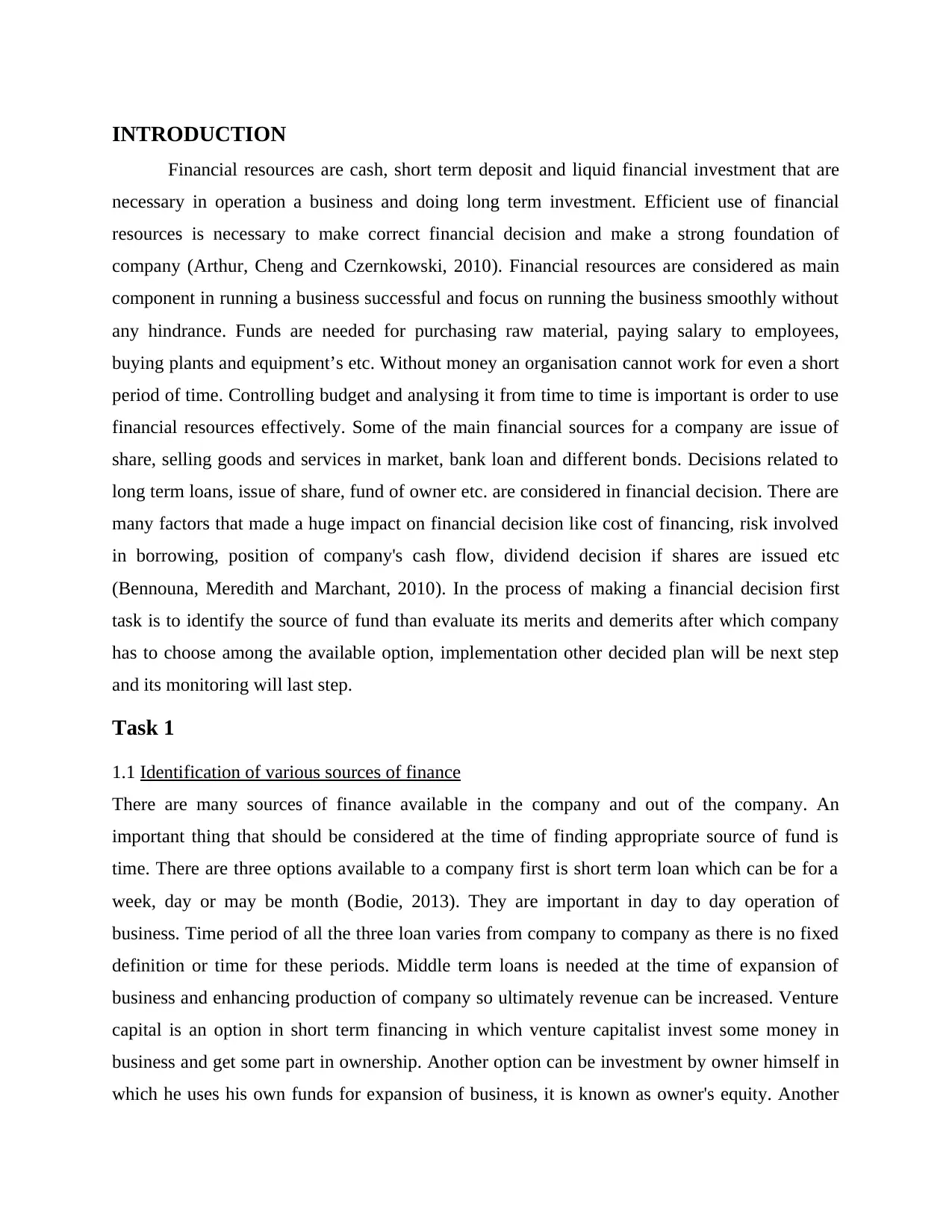
INTRODUCTION
Financial resources are cash, short term deposit and liquid financial investment that are
necessary in operation a business and doing long term investment. Efficient use of financial
resources is necessary to make correct financial decision and make a strong foundation of
company (Arthur, Cheng and Czernkowski, 2010). Financial resources are considered as main
component in running a business successful and focus on running the business smoothly without
any hindrance. Funds are needed for purchasing raw material, paying salary to employees,
buying plants and equipment’s etc. Without money an organisation cannot work for even a short
period of time. Controlling budget and analysing it from time to time is important is order to use
financial resources effectively. Some of the main financial sources for a company are issue of
share, selling goods and services in market, bank loan and different bonds. Decisions related to
long term loans, issue of share, fund of owner etc. are considered in financial decision. There are
many factors that made a huge impact on financial decision like cost of financing, risk involved
in borrowing, position of company's cash flow, dividend decision if shares are issued etc
(Bennouna, Meredith and Marchant, 2010). In the process of making a financial decision first
task is to identify the source of fund than evaluate its merits and demerits after which company
has to choose among the available option, implementation other decided plan will be next step
and its monitoring will last step.
Task 1
1.1 Identification of various sources of finance
There are many sources of finance available in the company and out of the company. An
important thing that should be considered at the time of finding appropriate source of fund is
time. There are three options available to a company first is short term loan which can be for a
week, day or may be month (Bodie, 2013). They are important in day to day operation of
business. Time period of all the three loan varies from company to company as there is no fixed
definition or time for these periods. Middle term loans is needed at the time of expansion of
business and enhancing production of company so ultimately revenue can be increased. Venture
capital is an option in short term financing in which venture capitalist invest some money in
business and get some part in ownership. Another option can be investment by owner himself in
which he uses his own funds for expansion of business, it is known as owner's equity. Another
Financial resources are cash, short term deposit and liquid financial investment that are
necessary in operation a business and doing long term investment. Efficient use of financial
resources is necessary to make correct financial decision and make a strong foundation of
company (Arthur, Cheng and Czernkowski, 2010). Financial resources are considered as main
component in running a business successful and focus on running the business smoothly without
any hindrance. Funds are needed for purchasing raw material, paying salary to employees,
buying plants and equipment’s etc. Without money an organisation cannot work for even a short
period of time. Controlling budget and analysing it from time to time is important is order to use
financial resources effectively. Some of the main financial sources for a company are issue of
share, selling goods and services in market, bank loan and different bonds. Decisions related to
long term loans, issue of share, fund of owner etc. are considered in financial decision. There are
many factors that made a huge impact on financial decision like cost of financing, risk involved
in borrowing, position of company's cash flow, dividend decision if shares are issued etc
(Bennouna, Meredith and Marchant, 2010). In the process of making a financial decision first
task is to identify the source of fund than evaluate its merits and demerits after which company
has to choose among the available option, implementation other decided plan will be next step
and its monitoring will last step.
Task 1
1.1 Identification of various sources of finance
There are many sources of finance available in the company and out of the company. An
important thing that should be considered at the time of finding appropriate source of fund is
time. There are three options available to a company first is short term loan which can be for a
week, day or may be month (Bodie, 2013). They are important in day to day operation of
business. Time period of all the three loan varies from company to company as there is no fixed
definition or time for these periods. Middle term loans is needed at the time of expansion of
business and enhancing production of company so ultimately revenue can be increased. Venture
capital is an option in short term financing in which venture capitalist invest some money in
business and get some part in ownership. Another option can be investment by owner himself in
which he uses his own funds for expansion of business, it is known as owner's equity. Another
⊘ This is a preview!⊘
Do you want full access?
Subscribe today to unlock all pages.

Trusted by 1+ million students worldwide
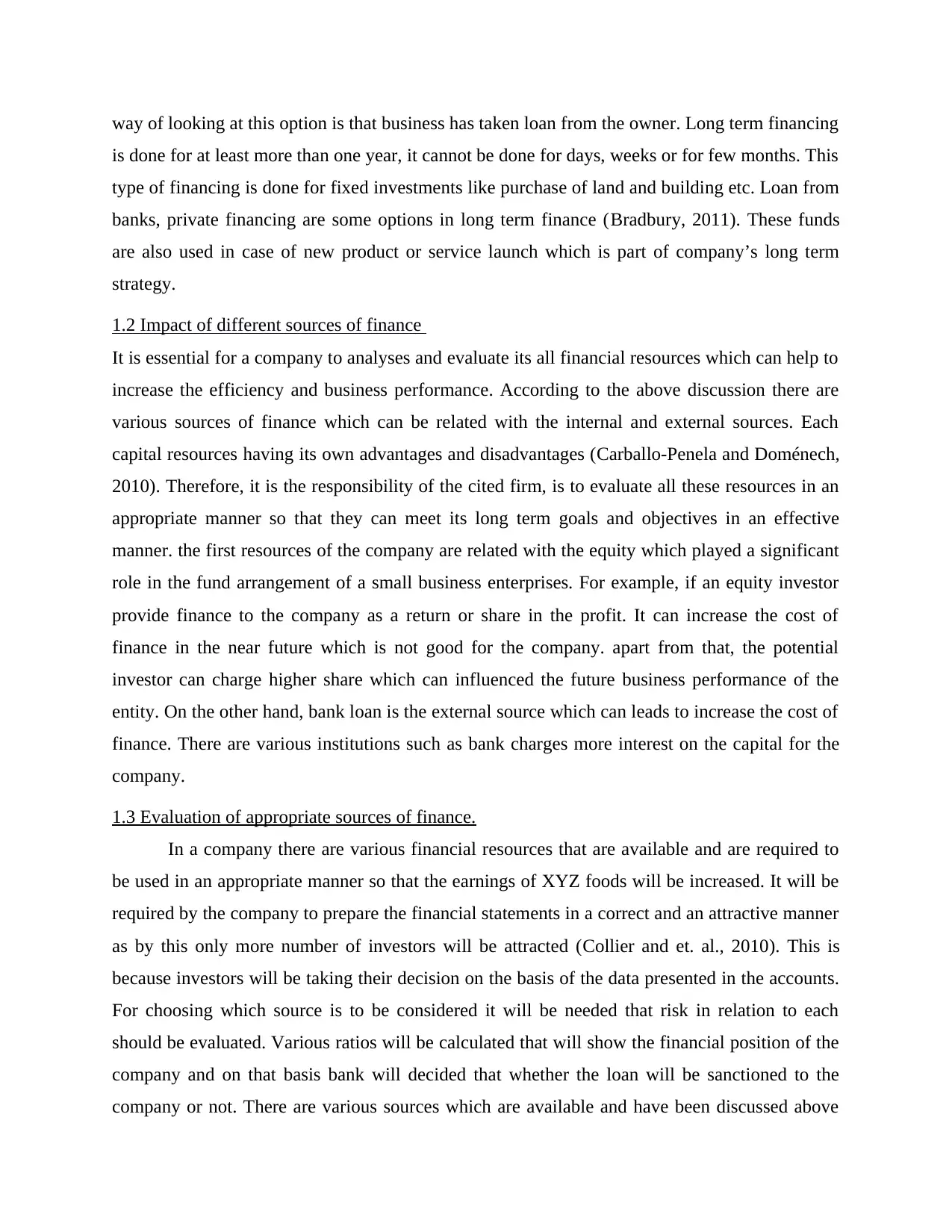
way of looking at this option is that business has taken loan from the owner. Long term financing
is done for at least more than one year, it cannot be done for days, weeks or for few months. This
type of financing is done for fixed investments like purchase of land and building etc. Loan from
banks, private financing are some options in long term finance (Bradbury, 2011). These funds
are also used in case of new product or service launch which is part of company’s long term
strategy.
1.2 Impact of different sources of finance
It is essential for a company to analyses and evaluate its all financial resources which can help to
increase the efficiency and business performance. According to the above discussion there are
various sources of finance which can be related with the internal and external sources. Each
capital resources having its own advantages and disadvantages (Carballo-Penela and Doménech,
2010). Therefore, it is the responsibility of the cited firm, is to evaluate all these resources in an
appropriate manner so that they can meet its long term goals and objectives in an effective
manner. the first resources of the company are related with the equity which played a significant
role in the fund arrangement of a small business enterprises. For example, if an equity investor
provide finance to the company as a return or share in the profit. It can increase the cost of
finance in the near future which is not good for the company. apart from that, the potential
investor can charge higher share which can influenced the future business performance of the
entity. On the other hand, bank loan is the external source which can leads to increase the cost of
finance. There are various institutions such as bank charges more interest on the capital for the
company.
1.3 Evaluation of appropriate sources of finance.
In a company there are various financial resources that are available and are required to
be used in an appropriate manner so that the earnings of XYZ foods will be increased. It will be
required by the company to prepare the financial statements in a correct and an attractive manner
as by this only more number of investors will be attracted (Collier and et. al., 2010). This is
because investors will be taking their decision on the basis of the data presented in the accounts.
For choosing which source is to be considered it will be needed that risk in relation to each
should be evaluated. Various ratios will be calculated that will show the financial position of the
company and on that basis bank will decided that whether the loan will be sanctioned to the
company or not. There are various sources which are available and have been discussed above
is done for at least more than one year, it cannot be done for days, weeks or for few months. This
type of financing is done for fixed investments like purchase of land and building etc. Loan from
banks, private financing are some options in long term finance (Bradbury, 2011). These funds
are also used in case of new product or service launch which is part of company’s long term
strategy.
1.2 Impact of different sources of finance
It is essential for a company to analyses and evaluate its all financial resources which can help to
increase the efficiency and business performance. According to the above discussion there are
various sources of finance which can be related with the internal and external sources. Each
capital resources having its own advantages and disadvantages (Carballo-Penela and Doménech,
2010). Therefore, it is the responsibility of the cited firm, is to evaluate all these resources in an
appropriate manner so that they can meet its long term goals and objectives in an effective
manner. the first resources of the company are related with the equity which played a significant
role in the fund arrangement of a small business enterprises. For example, if an equity investor
provide finance to the company as a return or share in the profit. It can increase the cost of
finance in the near future which is not good for the company. apart from that, the potential
investor can charge higher share which can influenced the future business performance of the
entity. On the other hand, bank loan is the external source which can leads to increase the cost of
finance. There are various institutions such as bank charges more interest on the capital for the
company.
1.3 Evaluation of appropriate sources of finance.
In a company there are various financial resources that are available and are required to
be used in an appropriate manner so that the earnings of XYZ foods will be increased. It will be
required by the company to prepare the financial statements in a correct and an attractive manner
as by this only more number of investors will be attracted (Collier and et. al., 2010). This is
because investors will be taking their decision on the basis of the data presented in the accounts.
For choosing which source is to be considered it will be needed that risk in relation to each
should be evaluated. Various ratios will be calculated that will show the financial position of the
company and on that basis bank will decided that whether the loan will be sanctioned to the
company or not. There are various sources which are available and have been discussed above
Paraphrase This Document
Need a fresh take? Get an instant paraphrase of this document with our AI Paraphraser
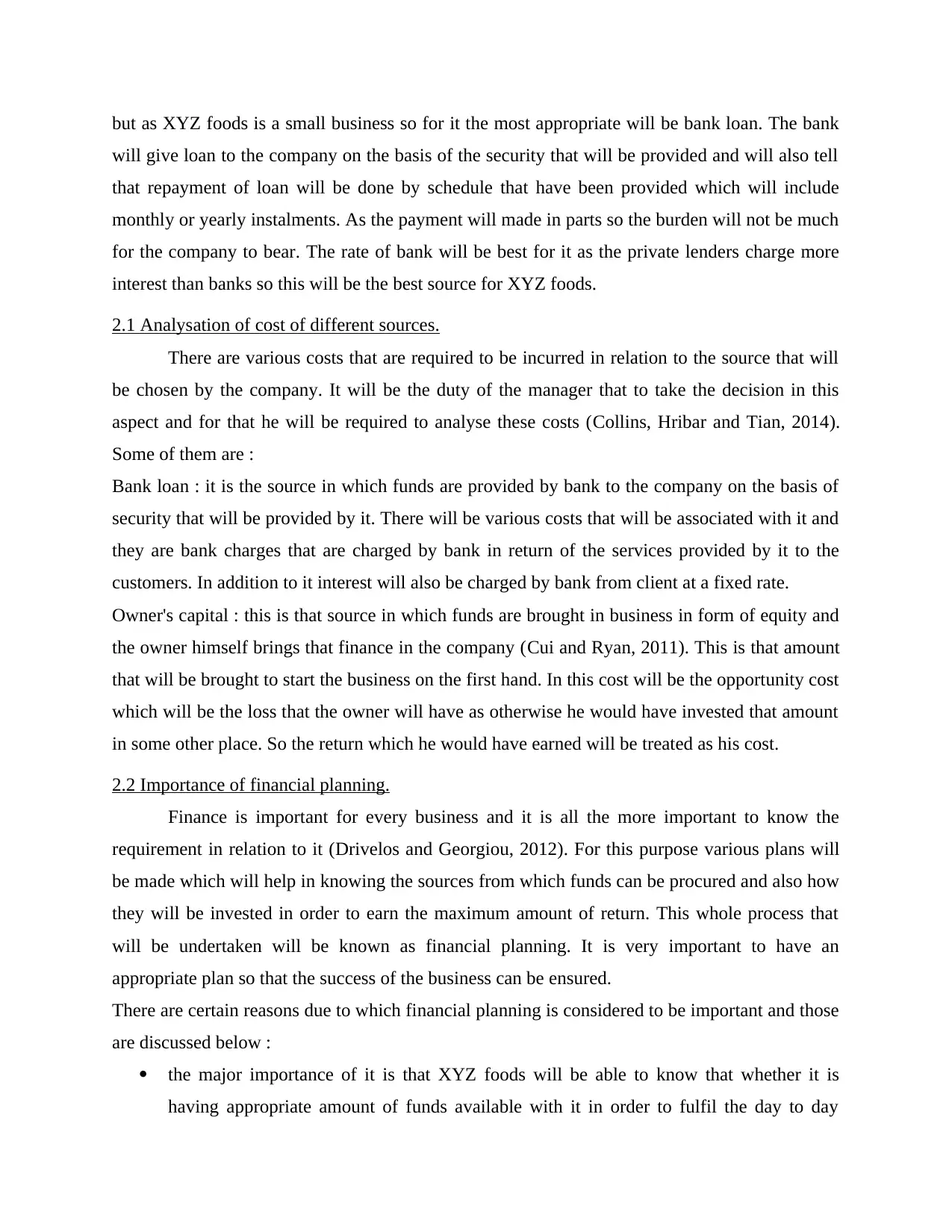
but as XYZ foods is a small business so for it the most appropriate will be bank loan. The bank
will give loan to the company on the basis of the security that will be provided and will also tell
that repayment of loan will be done by schedule that have been provided which will include
monthly or yearly instalments. As the payment will made in parts so the burden will not be much
for the company to bear. The rate of bank will be best for it as the private lenders charge more
interest than banks so this will be the best source for XYZ foods.
2.1 Analysation of cost of different sources.
There are various costs that are required to be incurred in relation to the source that will
be chosen by the company. It will be the duty of the manager that to take the decision in this
aspect and for that he will be required to analyse these costs (Collins, Hribar and Tian, 2014).
Some of them are :
Bank loan : it is the source in which funds are provided by bank to the company on the basis of
security that will be provided by it. There will be various costs that will be associated with it and
they are bank charges that are charged by bank in return of the services provided by it to the
customers. In addition to it interest will also be charged by bank from client at a fixed rate.
Owner's capital : this is that source in which funds are brought in business in form of equity and
the owner himself brings that finance in the company (Cui and Ryan, 2011). This is that amount
that will be brought to start the business on the first hand. In this cost will be the opportunity cost
which will be the loss that the owner will have as otherwise he would have invested that amount
in some other place. So the return which he would have earned will be treated as his cost.
2.2 Importance of financial planning.
Finance is important for every business and it is all the more important to know the
requirement in relation to it (Drivelos and Georgiou, 2012). For this purpose various plans will
be made which will help in knowing the sources from which funds can be procured and also how
they will be invested in order to earn the maximum amount of return. This whole process that
will be undertaken will be known as financial planning. It is very important to have an
appropriate plan so that the success of the business can be ensured.
There are certain reasons due to which financial planning is considered to be important and those
are discussed below :
the major importance of it is that XYZ foods will be able to know that whether it is
having appropriate amount of funds available with it in order to fulfil the day to day
will give loan to the company on the basis of the security that will be provided and will also tell
that repayment of loan will be done by schedule that have been provided which will include
monthly or yearly instalments. As the payment will made in parts so the burden will not be much
for the company to bear. The rate of bank will be best for it as the private lenders charge more
interest than banks so this will be the best source for XYZ foods.
2.1 Analysation of cost of different sources.
There are various costs that are required to be incurred in relation to the source that will
be chosen by the company. It will be the duty of the manager that to take the decision in this
aspect and for that he will be required to analyse these costs (Collins, Hribar and Tian, 2014).
Some of them are :
Bank loan : it is the source in which funds are provided by bank to the company on the basis of
security that will be provided by it. There will be various costs that will be associated with it and
they are bank charges that are charged by bank in return of the services provided by it to the
customers. In addition to it interest will also be charged by bank from client at a fixed rate.
Owner's capital : this is that source in which funds are brought in business in form of equity and
the owner himself brings that finance in the company (Cui and Ryan, 2011). This is that amount
that will be brought to start the business on the first hand. In this cost will be the opportunity cost
which will be the loss that the owner will have as otherwise he would have invested that amount
in some other place. So the return which he would have earned will be treated as his cost.
2.2 Importance of financial planning.
Finance is important for every business and it is all the more important to know the
requirement in relation to it (Drivelos and Georgiou, 2012). For this purpose various plans will
be made which will help in knowing the sources from which funds can be procured and also how
they will be invested in order to earn the maximum amount of return. This whole process that
will be undertaken will be known as financial planning. It is very important to have an
appropriate plan so that the success of the business can be ensured.
There are certain reasons due to which financial planning is considered to be important and those
are discussed below :
the major importance of it is that XYZ foods will be able to know that whether it is
having appropriate amount of funds available with it in order to fulfil the day to day
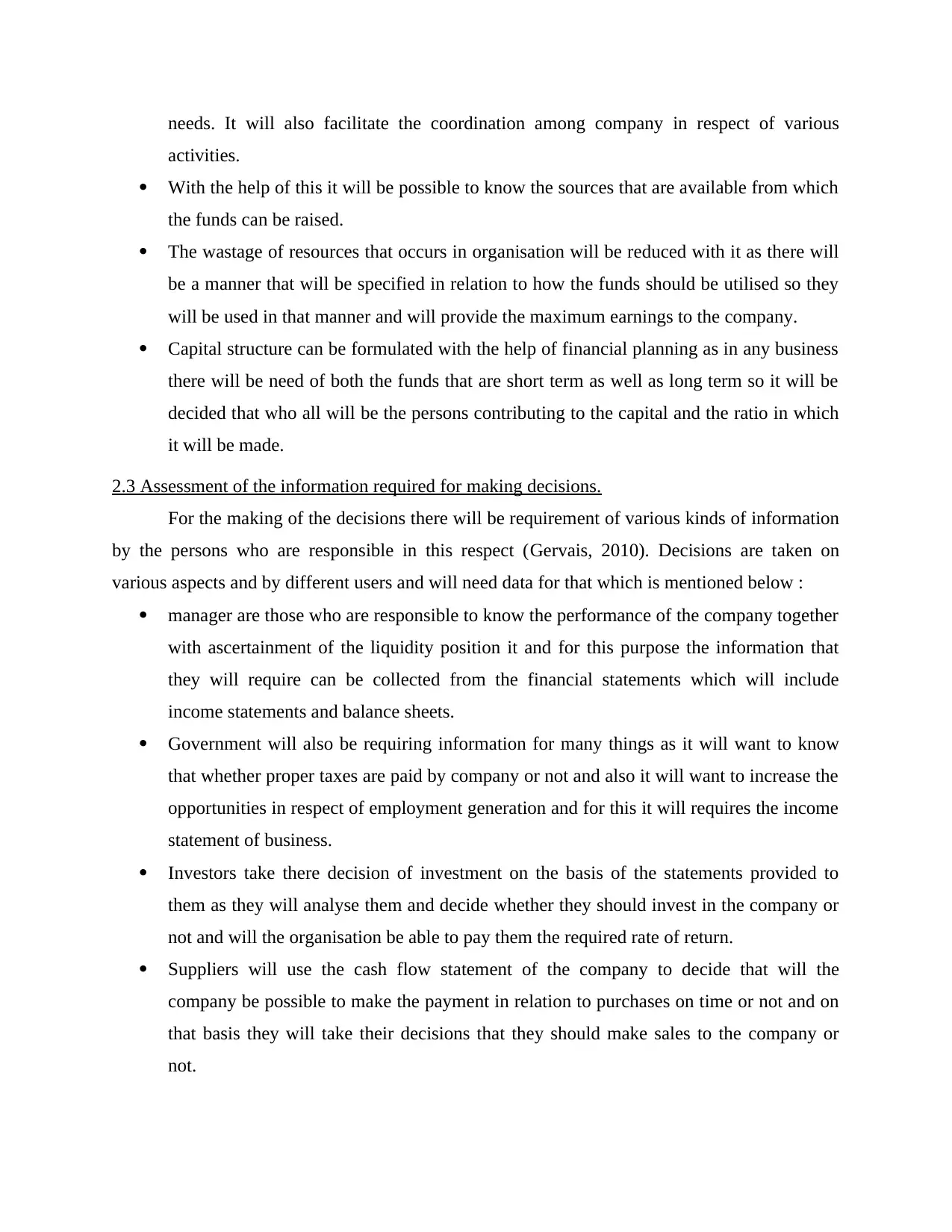
needs. It will also facilitate the coordination among company in respect of various
activities.
With the help of this it will be possible to know the sources that are available from which
the funds can be raised.
The wastage of resources that occurs in organisation will be reduced with it as there will
be a manner that will be specified in relation to how the funds should be utilised so they
will be used in that manner and will provide the maximum earnings to the company.
Capital structure can be formulated with the help of financial planning as in any business
there will be need of both the funds that are short term as well as long term so it will be
decided that who all will be the persons contributing to the capital and the ratio in which
it will be made.
2.3 Assessment of the information required for making decisions.
For the making of the decisions there will be requirement of various kinds of information
by the persons who are responsible in this respect (Gervais, 2010). Decisions are taken on
various aspects and by different users and will need data for that which is mentioned below :
manager are those who are responsible to know the performance of the company together
with ascertainment of the liquidity position it and for this purpose the information that
they will require can be collected from the financial statements which will include
income statements and balance sheets.
Government will also be requiring information for many things as it will want to know
that whether proper taxes are paid by company or not and also it will want to increase the
opportunities in respect of employment generation and for this it will requires the income
statement of business.
Investors take there decision of investment on the basis of the statements provided to
them as they will analyse them and decide whether they should invest in the company or
not and will the organisation be able to pay them the required rate of return.
Suppliers will use the cash flow statement of the company to decide that will the
company be possible to make the payment in relation to purchases on time or not and on
that basis they will take their decisions that they should make sales to the company or
not.
activities.
With the help of this it will be possible to know the sources that are available from which
the funds can be raised.
The wastage of resources that occurs in organisation will be reduced with it as there will
be a manner that will be specified in relation to how the funds should be utilised so they
will be used in that manner and will provide the maximum earnings to the company.
Capital structure can be formulated with the help of financial planning as in any business
there will be need of both the funds that are short term as well as long term so it will be
decided that who all will be the persons contributing to the capital and the ratio in which
it will be made.
2.3 Assessment of the information required for making decisions.
For the making of the decisions there will be requirement of various kinds of information
by the persons who are responsible in this respect (Gervais, 2010). Decisions are taken on
various aspects and by different users and will need data for that which is mentioned below :
manager are those who are responsible to know the performance of the company together
with ascertainment of the liquidity position it and for this purpose the information that
they will require can be collected from the financial statements which will include
income statements and balance sheets.
Government will also be requiring information for many things as it will want to know
that whether proper taxes are paid by company or not and also it will want to increase the
opportunities in respect of employment generation and for this it will requires the income
statement of business.
Investors take there decision of investment on the basis of the statements provided to
them as they will analyse them and decide whether they should invest in the company or
not and will the organisation be able to pay them the required rate of return.
Suppliers will use the cash flow statement of the company to decide that will the
company be possible to make the payment in relation to purchases on time or not and on
that basis they will take their decisions that they should make sales to the company or
not.
⊘ This is a preview!⊘
Do you want full access?
Subscribe today to unlock all pages.

Trusted by 1+ million students worldwide
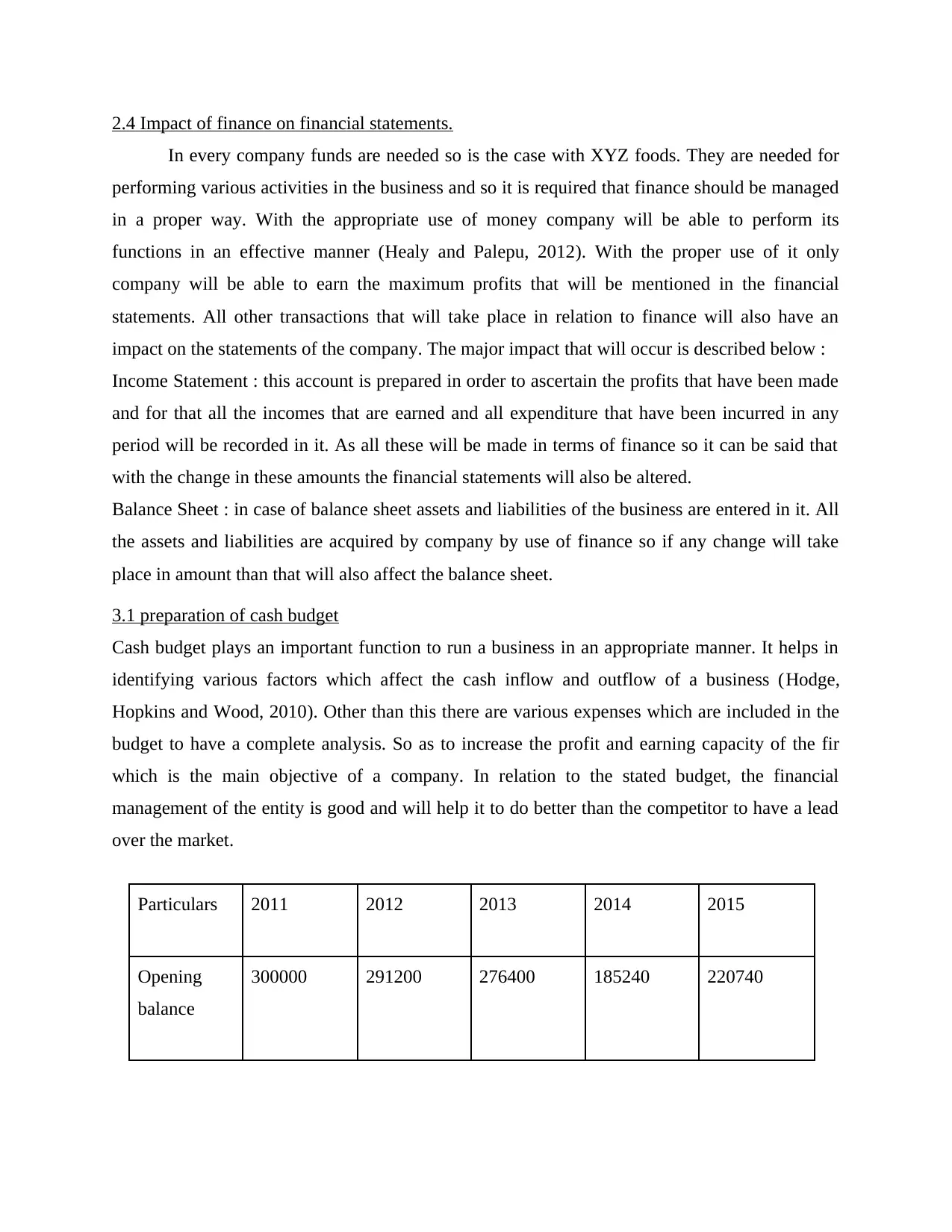
2.4 Impact of finance on financial statements.
In every company funds are needed so is the case with XYZ foods. They are needed for
performing various activities in the business and so it is required that finance should be managed
in a proper way. With the appropriate use of money company will be able to perform its
functions in an effective manner (Healy and Palepu, 2012). With the proper use of it only
company will be able to earn the maximum profits that will be mentioned in the financial
statements. All other transactions that will take place in relation to finance will also have an
impact on the statements of the company. The major impact that will occur is described below :
Income Statement : this account is prepared in order to ascertain the profits that have been made
and for that all the incomes that are earned and all expenditure that have been incurred in any
period will be recorded in it. As all these will be made in terms of finance so it can be said that
with the change in these amounts the financial statements will also be altered.
Balance Sheet : in case of balance sheet assets and liabilities of the business are entered in it. All
the assets and liabilities are acquired by company by use of finance so if any change will take
place in amount than that will also affect the balance sheet.
3.1 preparation of cash budget
Cash budget plays an important function to run a business in an appropriate manner. It helps in
identifying various factors which affect the cash inflow and outflow of a business (Hodge,
Hopkins and Wood, 2010). Other than this there are various expenses which are included in the
budget to have a complete analysis. So as to increase the profit and earning capacity of the fir
which is the main objective of a company. In relation to the stated budget, the financial
management of the entity is good and will help it to do better than the competitor to have a lead
over the market.
Particulars 2011 2012 2013 2014 2015
Opening
balance
300000 291200 276400 185240 220740
In every company funds are needed so is the case with XYZ foods. They are needed for
performing various activities in the business and so it is required that finance should be managed
in a proper way. With the appropriate use of money company will be able to perform its
functions in an effective manner (Healy and Palepu, 2012). With the proper use of it only
company will be able to earn the maximum profits that will be mentioned in the financial
statements. All other transactions that will take place in relation to finance will also have an
impact on the statements of the company. The major impact that will occur is described below :
Income Statement : this account is prepared in order to ascertain the profits that have been made
and for that all the incomes that are earned and all expenditure that have been incurred in any
period will be recorded in it. As all these will be made in terms of finance so it can be said that
with the change in these amounts the financial statements will also be altered.
Balance Sheet : in case of balance sheet assets and liabilities of the business are entered in it. All
the assets and liabilities are acquired by company by use of finance so if any change will take
place in amount than that will also affect the balance sheet.
3.1 preparation of cash budget
Cash budget plays an important function to run a business in an appropriate manner. It helps in
identifying various factors which affect the cash inflow and outflow of a business (Hodge,
Hopkins and Wood, 2010). Other than this there are various expenses which are included in the
budget to have a complete analysis. So as to increase the profit and earning capacity of the fir
which is the main objective of a company. In relation to the stated budget, the financial
management of the entity is good and will help it to do better than the competitor to have a lead
over the market.
Particulars 2011 2012 2013 2014 2015
Opening
balance
300000 291200 276400 185240 220740
Paraphrase This Document
Need a fresh take? Get an instant paraphrase of this document with our AI Paraphraser
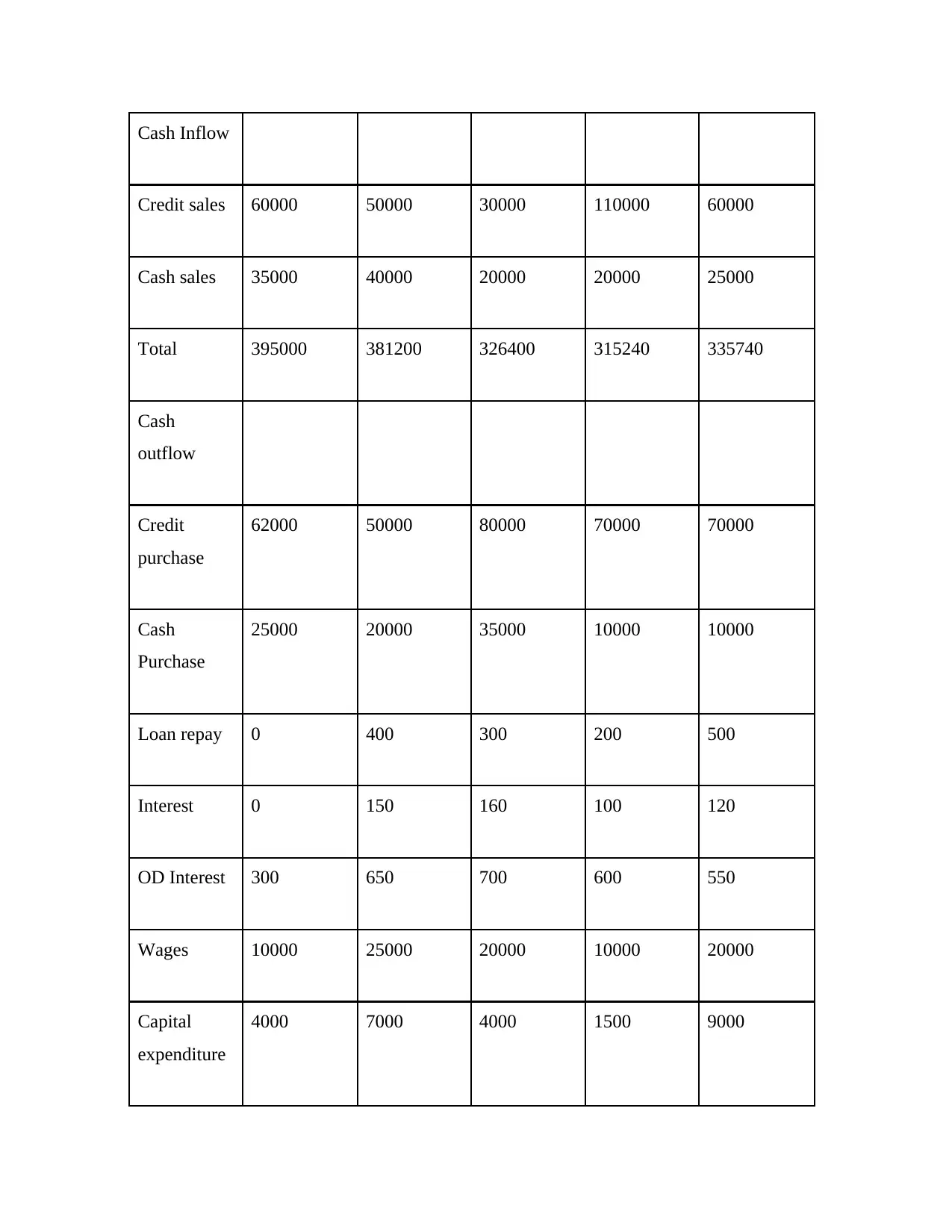
Cash Inflow
Credit sales 60000 50000 30000 110000 60000
Cash sales 35000 40000 20000 20000 25000
Total 395000 381200 326400 315240 335740
Cash
outflow
Credit
purchase
62000 50000 80000 70000 70000
Cash
Purchase
25000 20000 35000 10000 10000
Loan repay 0 400 300 200 500
Interest 0 150 160 100 120
OD Interest 300 650 700 600 550
Wages 10000 25000 20000 10000 20000
Capital
expenditure
4000 7000 4000 1500 9000
Credit sales 60000 50000 30000 110000 60000
Cash sales 35000 40000 20000 20000 25000
Total 395000 381200 326400 315240 335740
Cash
outflow
Credit
purchase
62000 50000 80000 70000 70000
Cash
Purchase
25000 20000 35000 10000 10000
Loan repay 0 400 300 200 500
Interest 0 150 160 100 120
OD Interest 300 650 700 600 550
Wages 10000 25000 20000 10000 20000
Capital
expenditure
4000 7000 4000 1500 9000
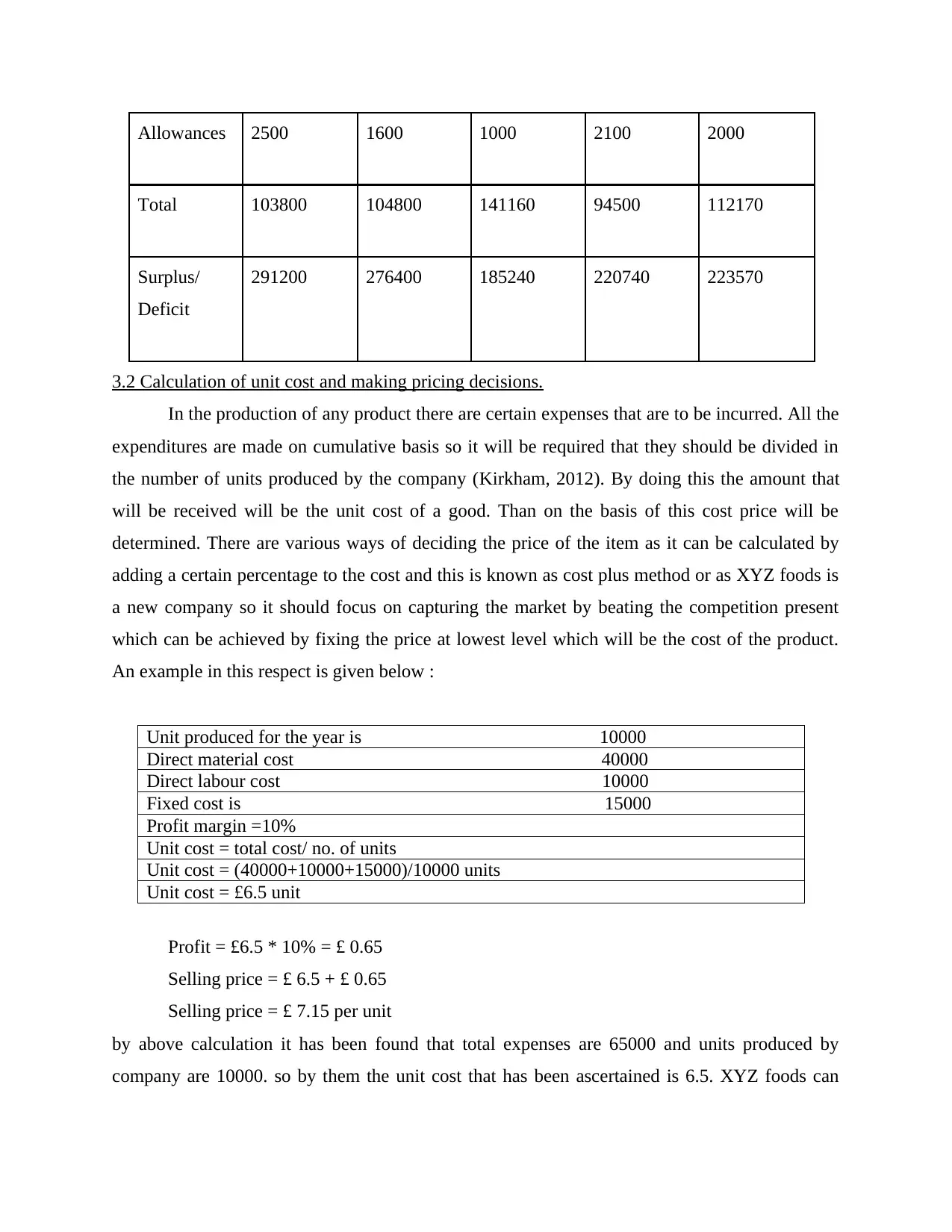
Allowances 2500 1600 1000 2100 2000
Total 103800 104800 141160 94500 112170
Surplus/
Deficit
291200 276400 185240 220740 223570
3.2 Calculation of unit cost and making pricing decisions.
In the production of any product there are certain expenses that are to be incurred. All the
expenditures are made on cumulative basis so it will be required that they should be divided in
the number of units produced by the company (Kirkham, 2012). By doing this the amount that
will be received will be the unit cost of a good. Than on the basis of this cost price will be
determined. There are various ways of deciding the price of the item as it can be calculated by
adding a certain percentage to the cost and this is known as cost plus method or as XYZ foods is
a new company so it should focus on capturing the market by beating the competition present
which can be achieved by fixing the price at lowest level which will be the cost of the product.
An example in this respect is given below :
Unit produced for the year is 10000
Direct material cost 40000
Direct labour cost 10000
Fixed cost is 15000
Profit margin =10%
Unit cost = total cost/ no. of units
Unit cost = (40000+10000+15000)/10000 units
Unit cost = £6.5 unit
Profit = £6.5 * 10% = £ 0.65
Selling price = £ 6.5 + £ 0.65
Selling price = £ 7.15 per unit
by above calculation it has been found that total expenses are 65000 and units produced by
company are 10000. so by them the unit cost that has been ascertained is 6.5. XYZ foods can
Total 103800 104800 141160 94500 112170
Surplus/
Deficit
291200 276400 185240 220740 223570
3.2 Calculation of unit cost and making pricing decisions.
In the production of any product there are certain expenses that are to be incurred. All the
expenditures are made on cumulative basis so it will be required that they should be divided in
the number of units produced by the company (Kirkham, 2012). By doing this the amount that
will be received will be the unit cost of a good. Than on the basis of this cost price will be
determined. There are various ways of deciding the price of the item as it can be calculated by
adding a certain percentage to the cost and this is known as cost plus method or as XYZ foods is
a new company so it should focus on capturing the market by beating the competition present
which can be achieved by fixing the price at lowest level which will be the cost of the product.
An example in this respect is given below :
Unit produced for the year is 10000
Direct material cost 40000
Direct labour cost 10000
Fixed cost is 15000
Profit margin =10%
Unit cost = total cost/ no. of units
Unit cost = (40000+10000+15000)/10000 units
Unit cost = £6.5 unit
Profit = £6.5 * 10% = £ 0.65
Selling price = £ 6.5 + £ 0.65
Selling price = £ 7.15 per unit
by above calculation it has been found that total expenses are 65000 and units produced by
company are 10000. so by them the unit cost that has been ascertained is 6.5. XYZ foods can
⊘ This is a preview!⊘
Do you want full access?
Subscribe today to unlock all pages.

Trusted by 1+ million students worldwide
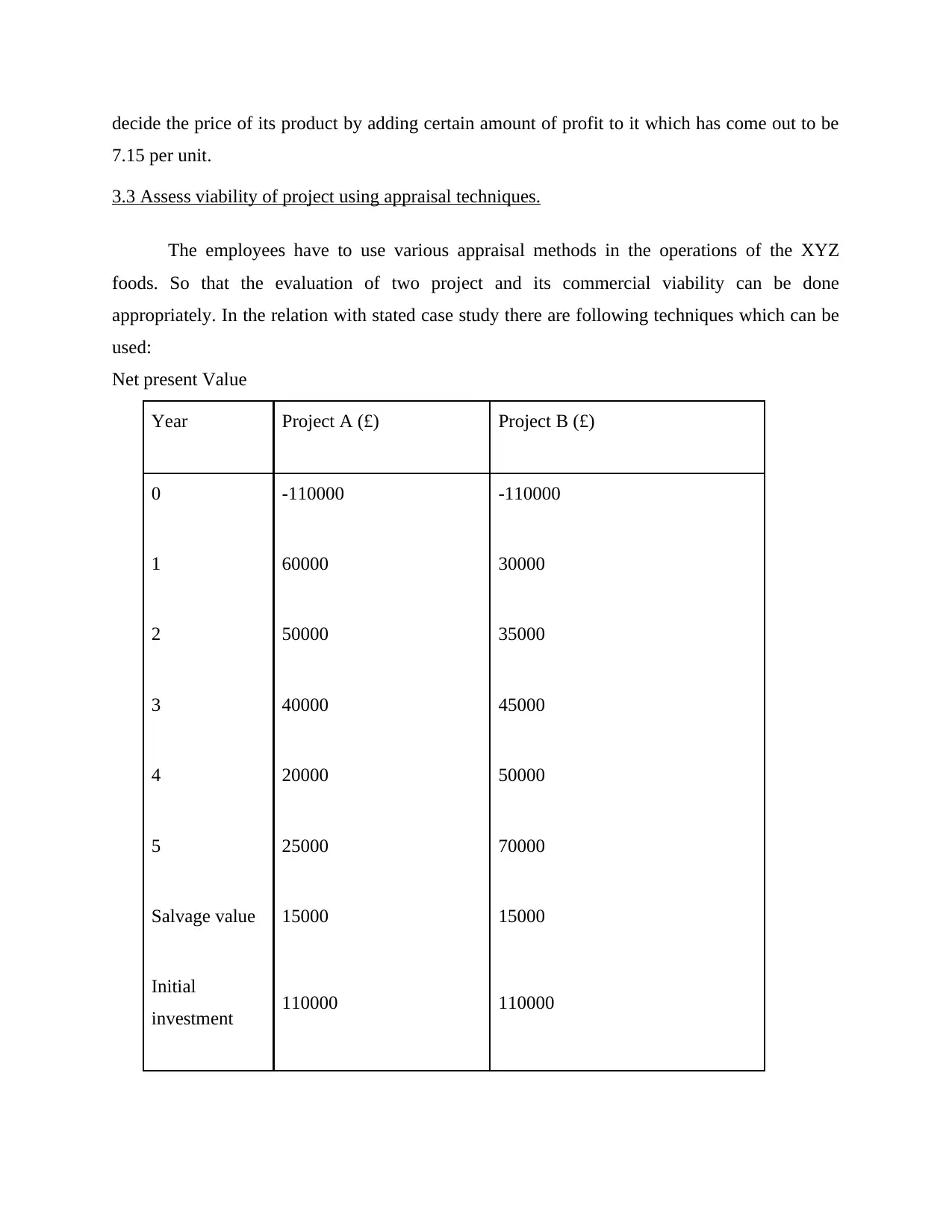
decide the price of its product by adding certain amount of profit to it which has come out to be
7.15 per unit.
3.3 Assess viability of project using appraisal techniques.
The employees have to use various appraisal methods in the operations of the XYZ
foods. So that the evaluation of two project and its commercial viability can be done
appropriately. In the relation with stated case study there are following techniques which can be
used:
Net present Value
Year Project A (£) Project B (£)
0 -110000 -110000
1 60000 30000
2 50000 35000
3 40000 45000
4 20000 50000
5 25000 70000
Salvage value 15000 15000
Initial
investment 110000 110000
7.15 per unit.
3.3 Assess viability of project using appraisal techniques.
The employees have to use various appraisal methods in the operations of the XYZ
foods. So that the evaluation of two project and its commercial viability can be done
appropriately. In the relation with stated case study there are following techniques which can be
used:
Net present Value
Year Project A (£) Project B (£)
0 -110000 -110000
1 60000 30000
2 50000 35000
3 40000 45000
4 20000 50000
5 25000 70000
Salvage value 15000 15000
Initial
investment 110000 110000
Paraphrase This Document
Need a fresh take? Get an instant paraphrase of this document with our AI Paraphraser
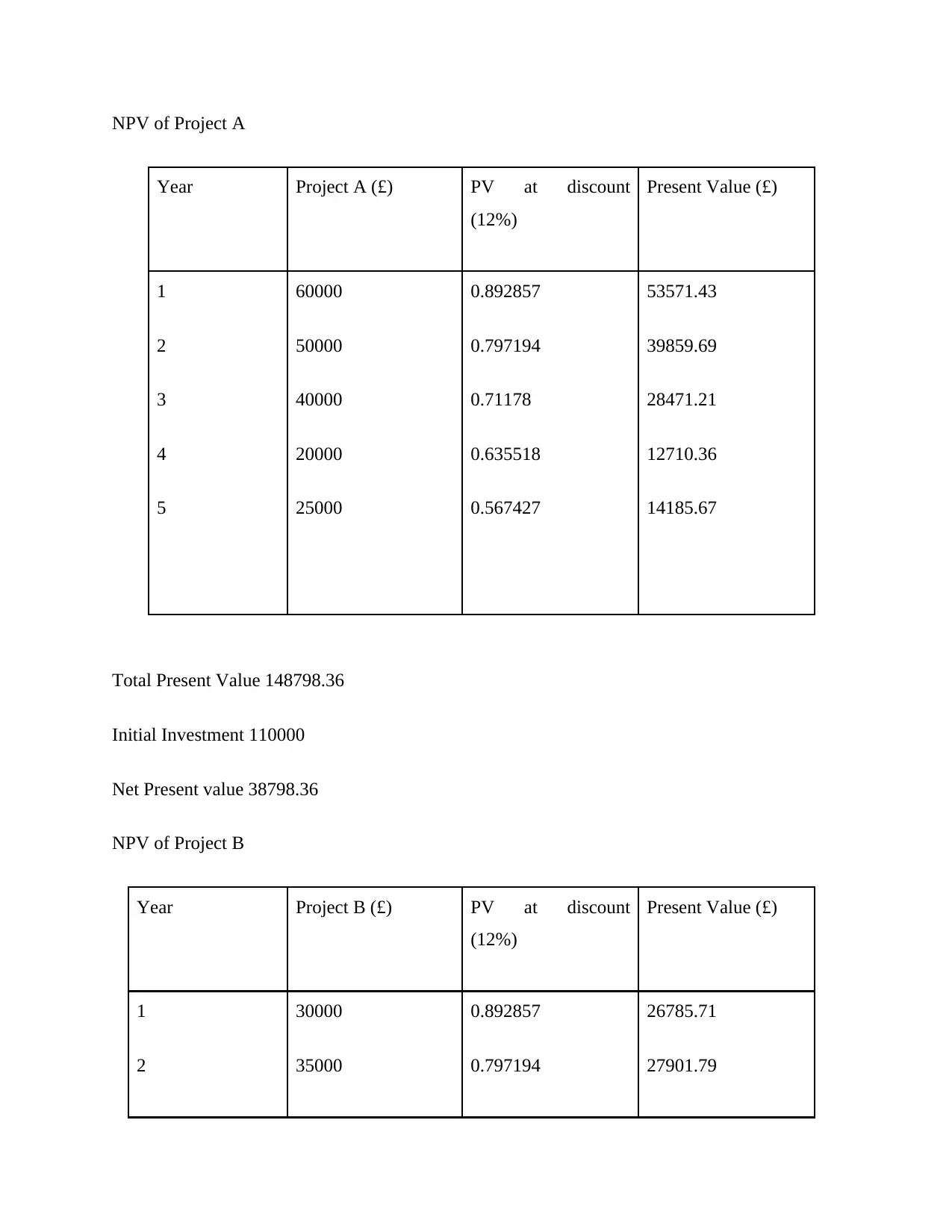
NPV of Project A
Year Project A (£) PV at discount
(12%)
Present Value (£)
1
2
3
4
5
60000
50000
40000
20000
25000
0.892857
0.797194
0.71178
0.635518
0.567427
53571.43
39859.69
28471.21
12710.36
14185.67
Total Present Value 148798.36
Initial Investment 110000
Net Present value 38798.36
NPV of Project B
Year Project B (£) PV at discount
(12%)
Present Value (£)
1
2
30000
35000
0.892857
0.797194
26785.71
27901.79
Year Project A (£) PV at discount
(12%)
Present Value (£)
1
2
3
4
5
60000
50000
40000
20000
25000
0.892857
0.797194
0.71178
0.635518
0.567427
53571.43
39859.69
28471.21
12710.36
14185.67
Total Present Value 148798.36
Initial Investment 110000
Net Present value 38798.36
NPV of Project B
Year Project B (£) PV at discount
(12%)
Present Value (£)
1
2
30000
35000
0.892857
0.797194
26785.71
27901.79
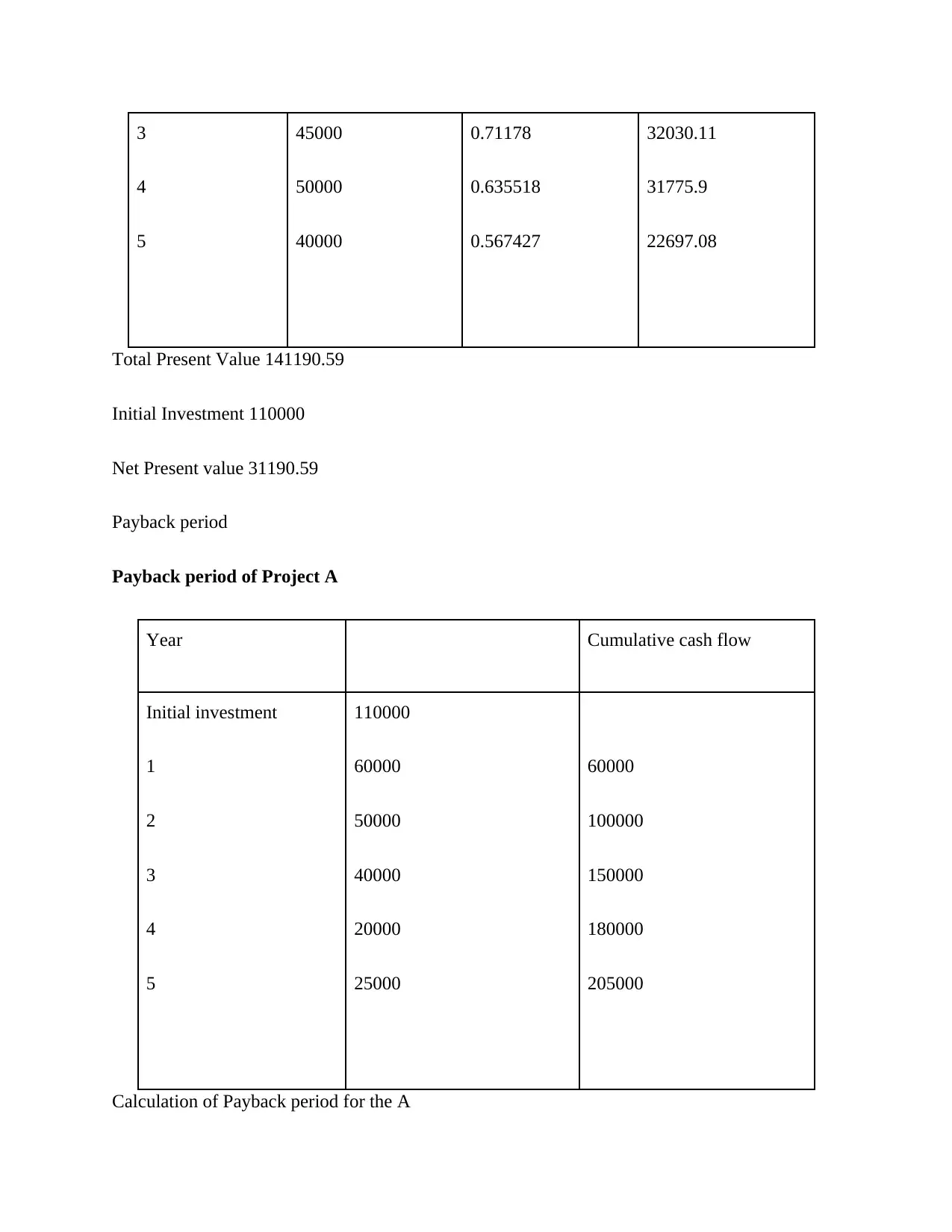
3
4
5
45000
50000
40000
0.71178
0.635518
0.567427
32030.11
31775.9
22697.08
Total Present Value 141190.59
Initial Investment 110000
Net Present value 31190.59
Payback period
Payback period of Project A
Year Cumulative cash flow
Initial investment
1
2
3
4
5
110000
60000
50000
40000
20000
25000
60000
100000
150000
180000
205000
Calculation of Payback period for the A
4
5
45000
50000
40000
0.71178
0.635518
0.567427
32030.11
31775.9
22697.08
Total Present Value 141190.59
Initial Investment 110000
Net Present value 31190.59
Payback period
Payback period of Project A
Year Cumulative cash flow
Initial investment
1
2
3
4
5
110000
60000
50000
40000
20000
25000
60000
100000
150000
180000
205000
Calculation of Payback period for the A
⊘ This is a preview!⊘
Do you want full access?
Subscribe today to unlock all pages.

Trusted by 1+ million students worldwide
1 out of 22
Related Documents
Your All-in-One AI-Powered Toolkit for Academic Success.
+13062052269
info@desklib.com
Available 24*7 on WhatsApp / Email
![[object Object]](/_next/static/media/star-bottom.7253800d.svg)
Unlock your academic potential
Copyright © 2020–2025 A2Z Services. All Rights Reserved. Developed and managed by ZUCOL.





